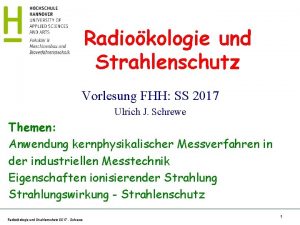Institut fr Radiokologie und Strahlenschutz IODINE129 AND IODINE127

- Slides: 1

Institut für Radioökologie und Strahlenschutz IODINE-129 AND IODINE-127 IN SEAWATER OF THE NORTH SEA AND IN PRECIPITATION FROM NORTHERN GERMANY A. Daraoui 1, R. Michel 1, M. Gorny 1, D. Jakob 1, R. Sachse 1, L. Tosch 1, H. Nies 2, I. Goroncy 2, J. Herrmann 2, H. -A. Synal 3, M. Stocker 3, V. Alfimov 3 1 Institut für Radioökologie und Strahlenschutz, Leibniz Universität Hannover, Germany 2 Bundesamt für Seeschifffahrt und Hydrographie (BSH) Hamburg, Germany 3 Ion Beam Physisc, Paul Scherrer Institut and ETH Zürich, 2093 Zürich, Switzerland contact: A. Daraoui Institut für Radioökologie und Strahlenschutz, Leibniz Universität Hannover, Herrenhäuser Str. 2, D-30419 Hannover. E-mail: daraoui@irs. uni-hannover. de . Introduction. Atmospheric nuclear weapons tests, nuclear accidents, and emissions from reprocessing plants have changed the natural abundances of 129 I (T 1/2=15. 7 Ma) in a sustainable manner. Mainly as a consequence of the 129 I releases from the European reprocessing plants, 129 I is in disequilibrium in all environmental compartments of the Western Europe. Objectives Methods The main goal of this study was to complement the results of the study St. Sch 4481 [Nies et al. 2010; Michel et al. 2012]. So we investigated the distribution and transport pathways of 129 I and 127 I in surface waters of the North Sea and the English Channel in 2009 and compared them with the data from 2005. Such knowledge is necessary to consider 129 I as an environmental tracer. A second goal of this study was to investigate the source of 129 I in precipitation samples in the northern Germany. Seawater samples were taken during a cruise of the BSH FS-Pelagia in August 2009 and were analysed for 129 I by accelerator mass spectrometry (AMS), and for 127 I by inductively coupled plasma mass spectrometry (ICPMS). For AMS measurements, the iodine from aqueous samples is separated from the matrix in two steps for. First, all iodine species are transferred into iodide. The second step consists of an ion exchange separation using a DOWEX® 1 x 8 analytical grade ion exchange resin. Results and Discussion v 129 I from La Hague is transported through the English Channel and to the North Sea (Fig. 1 and 2). It can be clearly distinguished along the coasts of Belgium, the Netherland, Germany and Denmark. Along the transport pathway, the 129 I activity concentrations decrease by no more than a factor of three. v. The 129 I/127 I ratios reveal the same pattern as the 129 I activity concentrations. This is due to the fact that 127 I just shows little variation in the samples analysed (Fig. 3). v. The 129 I activity concentrations in 2005 were generally higher than in 2009 (Fig. 4). Fig. 1: 129 I/127 I isotopic ratios in the North Sea and in the English Channel. Fig. 2: 129 I activity concentrations in m. Bq m-3 in the North Sea and in the English Channel. Fig. 3: 129 I/127 I isotopic ratios versus 127 I- and 129 Iconcentrations in the North Sea and the English Channel. v. The annual 129 I deposition rates start to increase and the data follow quite closely the rend of the total marine discharges from Sellafield and La Hague. The total atmospheric discharges have a completely different pattern (Fig. 5). Fig. 4: 129 I activity concentrations in m. Bq m-3 in 2005 and 2009 in the North Sea and in the English Channel. Fig. 5: Time series of 129 I deposition flux densities in rain water samples in Lower Saxony, Germany. Conclusions v The results of the investigation in 2009 reveal ongoing high 129 I contaminations in the North Sea and in the English Channel. v The variabilty of the 129 I/127 I isotopic ratios is exlusively determined by admixture of anthropogenic 129 I. v 129 I v Time series of the iodine isotopes in precipitation in Northern Germany demonstrate the decisive role of the marine discharges for the on-going 129 I atmospheric fallout in Western Europe. from La Hague is transported through the English Channel and to the North Sea. v Due to a higher dilution and a more complex current system, the 129 I signal from Sellafield is not so clear-cut in the North Sea. v The 129 I/127 I isotopic ratios with a maximum of 2. 7 x 10 -6 are at least four orders of magnitude higher than the natural isotopic ratio of 1. 5 10 -12. v 129 I is presently not of radiological significance, but it can be regarded as an indicator of the human long-term impact on the environment: 129 I can be used as tracer. References Acknowledgements Michel et al (2012), Science of the Total Environment 419, 151 -169. Nies et al (2010), final report St. Sch 4481, BMU 2010 The authors thank J. Döhring (NLWKN) for supplying the precipitation samples, and C. Vogt (IAC, Universität Hannover) for the opportunity to perform the ICP-MS measurenments.

